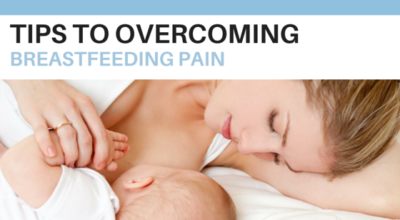Tips for Overcoming Breastfeeding Pain
Many women looked forward to the bonding experience they anticipate having while nursing their child. They understand that it will take some getting used to it and are prepared for the task. Once their baby is born, however, some find breastfeeding to be a painful experience.
If you or someone you know is experiencing pain while breastfeeding, don’t give up. Help is out there. We put together the following tips to help moms overcome the most common causes of breastfeeding pain.
- Proper Latching

The biggest culprit for breastfeeding pain is improper latching. Proper positioning is the cornerstone of successful breastfeeding and is the foundation of a good latch, especially during the early weeks.
When properly latched, minor discomfort may be experienced for only about a minute as the baby initially pulls in the nipple and areola. If pain is felt longer than this length of time, try repositioning the baby on your breast. A breastfeeding support pillow can help get the baby in the proper position.
Signs of a good latch are:
- Baby’s lips are flanged (think fish lips)
- Baby’s nose is nearly touching the breast
- Baby’s mouth should cover as much of the areola as possible while nursing
- Baby’s chin should press into the lower half of the mother’s breast
While it is normal to experience some tenderness when first starting breastfeeding, there may be other issues at play. If you still are having trouble with pain or attaining a good latch a week after starting nursing, don’t give up. Contact a lactation consultant as soon as possible.
- Infection
Sometimes moms have been successfully breastfeeding for months and then all of a sudden begin experiencing pain. This is often due to a bacterial or yeast infection. It is important that moms and their babies not delay receiving medical care to treat infections, so they can get back on track quickly.
Pain can also be caused by a nipple bleb, which is a tiny white blister found on the tip of the nipple. Warm compresses and frequent nursing is often the best treatment.
- Tongue-tie
Tongue-tie is the inability of the baby to lift their tongue or move it forward, causing them to be unable to nurse. Babies with tongue-tie will pull the nipple up toward their hard palate while sucking, which causes pain and damage to the nipple. Babies with tongue-tie are unable to stick their tongue out past their bottom lip. Medical professionals can remove the membrane that restricts the tongue’s movement, which will alleviate the problem.
- Nipple Abrasions
There is no doubt that trying to breastfeed a baby with cracked nipples is a painful experience. Moms with nipple abrasions should breastfeed on the uninjured side first. They can also apply an ice pack to the injured nipple to temporarily numb it. This will help make latching a less painful experience. To promote wound healing, apply breast milk to nipples. You can also apply a medical grade lanolin ointment if thrush is not the culprit.
- Nipple Vasospasm
A condition that turns nipples white after a feeding is called nipple vasospasm, or Raynaud’s syndrome. This occurs when blood vessels constrict and begin to spasm. This condition can be exacerbated when the mother is cold. Applying warm compresses to the breast immediately following breastfeeding may help, however, home remedies should never replace seeking assistance from a health professional.
Breastfeeding is truly a wonderful experience. If you or someone you know is experiencing breastfeeding pain, contact our lactation specialist today.







